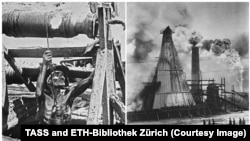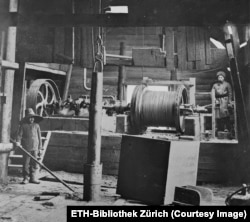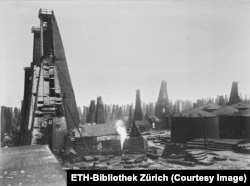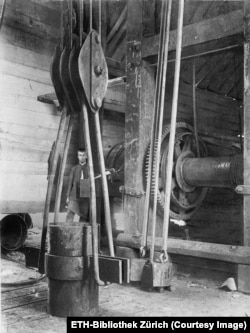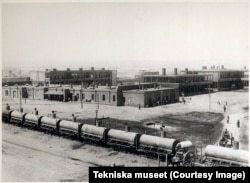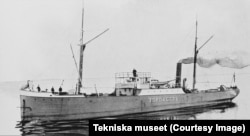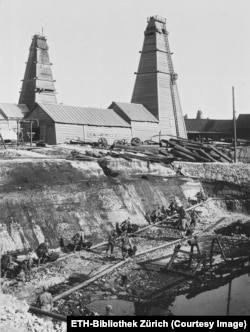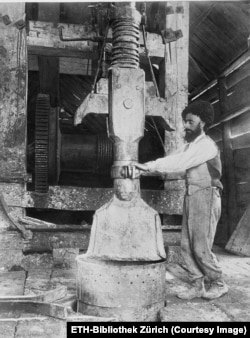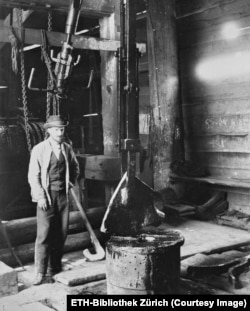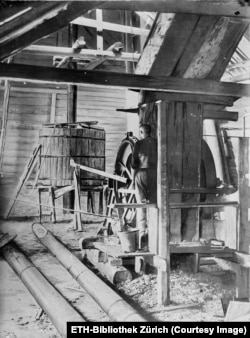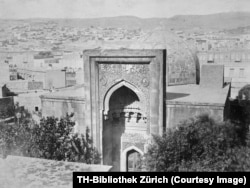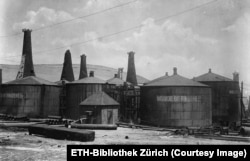Spectacular historical photos of the fiery, fortune-making oil fields of the Caucasus that once supplied half of the world’s "black gold."
This photo of an oil blowout near Baku is one of several pictures held by Zurich’s ETH Library that capture the oil boom in the Caucasus city in the early 1900s.
When these photos were taken in 1912, in today's Azerbaijan, the area was part of the Russian Empire.
The region was long known for being rich in oil. The explorer Marco Polo is believed to have described Baku when he wrote "Near the Georgian border there is a spring from which gushes a stream of oil in such abundance that a hundred ships may load there at once. This oil is not good to eat; but it is good for burning and as a salve for men and camels affected with itch or scab."
Around the time these photos were taken, the Baku oil fields supplied approximately half of all the world's oil.
The derricks are covered by wood panels to protect workers from rain and snow, and built tall enough for long drilling tools and well casings to be hoisted up and lowered into the wells.
The spectacular oil rush was driven largely by Russian and foreign entrepreneurs such as two of Sweden’s Nobel brothers, Robert and Ludvig, who founded the Branobel oil company in Baku in 1878.
The Branobel company name is an abbreviation of the Russian "Bratyev Nobel" -- Nobel Brothers.
The Nobels grew spectacularly wealthy from the Baku oil fields after solving transportation problems by installing oil pipelines and building the world’s first oil tanker (above), in 1878.
In 1906, the world's longest pipeline was completed, funneling kerosene 885 kilometers westward from Baku on the Caspian Sea to Batumi in today's Georgia.
The main oil extraction method at the time was "cable tool" or "percussion" drilling in which a chisel-like impact tool was lowered into the well and then repeatedly slammed into the rock below.
When the stone-cutting tools were lifted out to be sharpened, steel baskets lifted the broken rock to the surface.
The lifting and dropping of the impact tools was powered by steam engines (above), making Baku’s vast "forest" of oil derricks a noisy and immensely dangerous place.
Cable tool drilling often resulted in sudden blowouts, or "gushers," when workers cracked into a pressurized reservoir of oil deep below the surface.
Sizzling-hot steam engines inside the derricks meant that explosions were commonplace. The violence of a blowout is portrayed in the 2007 film There Will Be Blood.
It is unknown how many workers died in the oil fields of Baku in the early years. In 1905, six laborers were killed in clashes over working conditions. A news report noted that, after widespread violence in the oil fields, workmen were granted "a nine-and-a-half-hour day, with an eight-hour day preceding holidays."
Baku was known at the time as a rough corner of the Russian Empire. Ludvig Nobel described Baku as "a rather disagreeable hole."
After the Bolshevik Revolution, the oil company owners were forced to abandon the Baku oil fields and production slowed to a trickle.
A lasting legacy of the Baku oil rush are the annual Nobel Prizes that were founded by Alfred Nobel in 1895 and today come with a cash award of more than $1 million. As well as making his own fortune from the invention of dynamite, Alfred Nobel was an early investor in his brothers' Branobel oil company.
